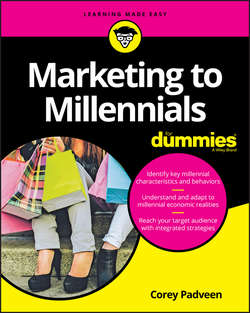Читать книгу Marketing to Millennials For Dummies - Padveen Corey - Страница 10
На сайте Литреса книга снята с продажи.
Part 1
Getting Started with Marketing to Millennials
Chapter 2
Creating a Modern View of Millennials
The Millennial Mindset
ОглавлениеIf you think about your Millennial audience without the constraints of age, you begin to understand that in some ways the term Millennial is becoming synonymous with consumer. The traits exhibited by Millennials, the largest and most influential demographic of consumers in the United States, are traits that marketers can apply to individuals across a multitude of demographics. Understanding and adapting to a new age of consumer habits and traits will set you up for long-term success.
Defining the Millennial
If you look beyond the scope of age, how would you define Millennial consumers? Giving them a singular definition would be dangerous because it significantly limits the audience. You need two definitions when discussing Millennials so that you can properly analyze them:
❯❯ Age: The first definition of Millennial consumers has to do with age range. Use this definition when discussing data about the consumers. Demographers, sociologists, social anthropologists, and marketers use age to conduct studies and collect data. (Most hard data collected applies age restrictions to this group.)
❯❯ Interests and behaviors: The second definition for the Millennial consumer is much more broad. Instead of focusing on age range data, you need to turn your attention to interests and behaviors. In these audience segments, the definition of Millennial extends far beyond age restrictions. Here, you look at like-minded consumers that fit a series of behavioral criteria. You can broadly define this category of Millennials as being tech-savvy, price-sensitive consumers who place their trust in peers and experts over brands. They digest information at a rapid rate and look for tailored, personalized brand experiences. Brand familiarity is less important to these consumers than relationships. When they form these relationships, they’re fiercely loyal.
You can find out more about building segmented groups and developing more detailed definitions of your targeted Millennial audience in Chapter 3.
Identifying preferred Millennial media
When compared to a generation ago, you can have a presence on an endless array of media. Ideally, having such a vast presence also means you have a strategy and a budget. To maximize your budget, you need to find and target the specific platforms your audience uses. Here are some points to keep in mind, when you begin to identify your audience’s preferred media:
❯❯ Start with Facebook. The majority of online Millennials say they are active on Facebook. This means that you’re almost certain to find some of your Millennial audience on Facebook. Despite what marketers and news outlets have said, Facebook is far from being irrelevant to Millennials. In fact, Facebook and its products have become so commonplace that Millennials don’t even realize how inextricably linked to it they are. Facebook is a great place to begin the process of analyzing your audience.
❯❯ Match email lists before building strategies. Before you begin building a strategy for a particular channel, you should either run an email match audience analysis or extract data using an ad platform. This step will help you determine whether a channel is worth investing in for the purpose of acquiring and retaining Millennial consumers.
Running an email match audience analysis is the process of uploading an owned email database to match emails with users on a given network and then analyzing aggregated data in order to identify marketing opportunities within a network or audience. (See Chapter 3 for more on this topic.)
❯❯ Identify top interests in your audience analysis. When conducting your audience analysis, you should pay close attention to topics of specific interest to Millennials. Certain content makes some media more attractive for investment than others. (For more details on this type of analysis and the types of content most effectively used on certain media, check out Chapters 5 and 6.)
❯❯ Evaluate content requirements and access. If your brand isn’t built for specific channels like Instagram (https://instagram.com) or Snapchat (https://snapchat.com), which are predominantly visual and entirely mobile, then making the investment to use them may not be worth it.
Finding a way to be relevant on these kinds of media is ideal, but if you don’t fit, your investment will go to waste. It makes more sense to focus on platforms that are ideally suited for your brand and content.
Grasping the importance of relationships
One of the overarching themes of Millennial engagement is the value placed on relationships. The importance of relationships is something that transcends media, brand recognition, and even quality of some products or services. Millennials engage primarily in impersonal spaces, so when a real, genuine connection is felt with an organization, it lasts a long time and can lead to loyalty and even brand advocacy.
One long-term goal of any organization should be to cultivate brand advocates from within their Millennial market. Brand advocates help promote your brand and expand your horizons. Advocates decrease marketing costs and open up new doors for marketing and advertising.
Конец ознакомительного фрагмента. Купить книгу
